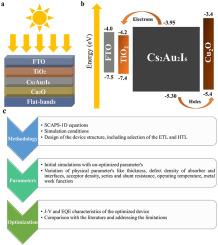Optimization of mixed valence Cs2Au2I6-based double perovskite solar cells by SCAPS-1D simulation
IF 4.9
3区 材料科学
Q2 CHEMISTRY, MULTIDISCIPLINARY
引用次数: 0
Abstract
Within the realm of photovoltaics (PVs), perovskite solar cells (PSCs) have garnered substantial interest as a result of their cost-effective production methods, high power conversion efficiency (PCE), and adaptable implementation designs. Nevertheless, the environmental sustainability and toxicity of lead (Pb)-based materials in PSCs present challenges. In the ongoing pursuit of superior PV materials, this study examines the PV potential of the all-inorganic mixed-valence Cs2Au2I6 double perovskite (PVK). By applying the solar cell capacitance simulator-one dimensional (SCAPS-1D), a comprehensive simulation analysis is performed. The PV properties are assessed by modifying the bulk defect density (Nt, bulk), doping levels, layer thicknesses, and HTL/PVK and PVK/ETL interface defects. The performance of Cs2Au2I6 PSCs is additionally assessed in terms of temperature, metal work function, and series and shunt resistance. The results unequivocally indicate that the proposed PSC, which utilizes Cu2O as the hole transport layer (HTL) and TiO2 as the electron transport layer (ETL), exhibits an exceptional PV efficiency. The simulated PSC achieves a fill-factor (FF) of 84.52 %, a short-circuit current density (JSC) of 31.77 mA/cm2, and an open-circuit voltage (VOC) of 1.11 V, and an efficiency of 29.88 % after optimizing the device parameters. This systematic computational analysis offers valuable insights and establishes a workable future path for the development of Cs2Au2l6-based solar cells.

基于SCAPS-1D模拟的混合价cs2au2i6基双钙钛矿太阳能电池优化
在光伏(pv)领域,钙钛矿太阳能电池(PSCs)由于其具有成本效益的生产方法,高功率转换效率(PCE)和适应性强的实现设计而获得了极大的兴趣。然而,pcsc中铅基材料的环境可持续性和毒性面临挑战。在不断追求优质光伏材料的过程中,本研究考察了全无机混价Cs2Au2I6双钙钛矿(PVK)的光伏潜力。利用一维太阳能电池电容模拟器(SCAPS-1D),进行了全面的仿真分析。通过改变体积缺陷密度(Nt, bulk),掺杂水平,层厚度以及html /PVK和PVK/ETL界面缺陷来评估PV性能。Cs2Au2I6 PSCs的性能还可以从温度、金属功功能、串联和分流电阻等方面进行评估。结果明确表明,采用Cu2O作为空穴传输层(HTL)和TiO2作为电子传输层(ETL)的PSC具有优异的PV效率。优化器件参数后,模拟PSC的填充系数(FF)为84.52%,短路电流密度(JSC)为31.77 mA/cm2,开路电压(VOC)为1.11 V,效率为29.88%。这一系统的计算分析提供了有价值的见解,并为基于cs2au216的太阳能电池的发展建立了可行的未来路径。
本文章由计算机程序翻译,如有差异,请以英文原文为准。
求助全文
约1分钟内获得全文
求助全文
来源期刊
CiteScore
7.80
自引率
2.50%
发文量
605
审稿时长
40 days
期刊介绍:
The Journal of Physics and Chemistry of Solids is a well-established international medium for publication of archival research in condensed matter and materials sciences. Areas of interest broadly include experimental and theoretical research on electronic, magnetic, spectroscopic and structural properties as well as the statistical mechanics and thermodynamics of materials. The focus is on gaining physical and chemical insight into the properties and potential applications of condensed matter systems.
Within the broad scope of the journal, beyond regular contributions, the editors have identified submissions in the following areas of physics and chemistry of solids to be of special current interest to the journal:
Low-dimensional systems
Exotic states of quantum electron matter including topological phases
Energy conversion and storage
Interfaces, nanoparticles and catalysts.

 求助内容:
求助内容: 应助结果提醒方式:
应助结果提醒方式:


